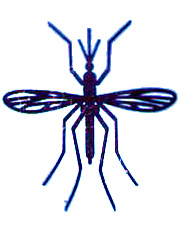New places bring new challenges, and unfortunately insects are one of those challenges. Some bugs are harmless, and some are a real threat to health. Some fly (or walk!) themselves aboard, and some we carry aboard unwittingly, while others we need to worry about we encounter ashore.
But don’t let fear of bugs stunt your adventure! Knowing the realities versus hearsay and being ready with precautions and remedies before the critters come winging your way is a huge help. The Admirals, as they say, have been there, done that, and below are their tips.
Before we enumerate a long list, in reality bug issues won’t likely be as bad as it may end up sounding. Problems are occasional, not everyday. Simple precautions, along with actions taken promptly, nip in the bud quickly what does come up.
There are actually bugs we enjoy.
Butterflies flitting over the water are a delightful surprise from Mother Nature. Likewise dragonflies, resting on a lifeline, are fascinating to examine… plus they eat mosquitoes and no-see-ums. Moths, drawn after dark into cockpit and cabin by electric lights, may edge toward irritating as they flutter between you and your book, but no harm’s done.
A more alarming nighttime visitor in the tropics can be a swarm of flying termites.
Like a horror movie, they stream in through an opening, before committing hari kari en masse. When it happened to us, we sucked up every body and wing with a vacuum, but I worried about infestation for years after. Internet articles say, however, that such swarming termites are usually colonizing “kings and queens” without the destructive “workers.” Wish I’d know THAT ten years ago!
However, drywood termites, the usual kind that cause trouble with boats, not only cause serious damage to wooden interiors, cores, or hulls, but can create issues with entry into certain countries like Australia. They typically get aboard from an infested boat nearby. Signs are discarded wings and unexplained ‘sawdust’ that is actually termite poop. Quick action with topical or injected treatments can be enough, but unfortunately complete tenting is the ultimate solution.
Bugs we perceive as a threat to cleanliness are flies, ants, spiders and cockroaches, yet cleanliness aboard (no crumbs on counters or dirty dishes) is the first line of defense.
Flies seem to show up anywhere they choose.
They are most commonly the result of poor garbage control (either yours, the nearest town’s, or Mother Nature’s!). Old-fashioned swatting or modern zapping with electric Racket Zappers are the most sporting methods of control, but sticky fly-paper strips work well too. Put strips near where flies congregate or near “bait” like a bit of jam in a jar.
Ripening fruit seems to draw fruit flies out of thin air. Intercept them by washing fruit before bringing it below, then cover fruit with a mesh dome or round of netting weighted along the edge. Stalks of bananas are best dipped right in seawater to urge bugs of all kinds, including spiders, to miss the cruise.

Since ants, spiders, and cockroaches can walk aboard, they’re often a byproduct of visits to marinas or boatyards.
For the walk-ons, putting aromatic spices – like cayenne pepper – on your dock lines discourages new arrivals. Roaches can also come aboard in cardboard, especially corrugated. Cruisers quickly learn to divest themselves of packaging materials before reaching the boat. One couple I knew undressed everything into Ziploc bags before leaving the supermarket!
If crawlies get aboard, act promptly before things get out of control. Major fumigations, bombs or industrial sprays are harder on the humans than the bugs. The most recommended counterattack for ants is Terro Ant Poison; for cockroaches, Boric Acid and Combat Traps or Gel.
Interestingly, temperatures over 120 degrees are said to be lethal to ants and cockroaches, perhaps one reason we don’t always find bugs when we might expect to after boatyard storage! Hard to be sure since we tend to go on the offensive with traps, sprays, Boric Acid and bug bombs prior to leaving our boats on the hard.
For pet owners, fleas are certainly an issue.
You may not find your monthly treatments in out of the way places, so bring enough with you to keep your pet flea free. It’s probably wise to bring sprays in the event you miss your schedule.
Another bug we carry aboard is the weevil lurking in flours and grains.
To prevent weevils from hatching are several home remedies: microwaving packages before stowing (this makes flour clumpy), adding a lump of dry ice, or stowing it in a canister or Ziploc with several bay leaves. If weevils hatch, either sieve them out or… consider them free protein in the day’s baking.
Nobody likes to see stinging insects like bees or wasps fly aboard, but for those allergic, it can be serious.
Obviously, anyone with allergies should not go to sea without multiple sting kits. Many wasps have a sweet tooth, attracted by (but also caught by) things like empty soda cans. In Mexico, bees sometimes come seeking fresh water in a damp sink. A small bowl on the foredeck will draw them away from living spaces.

Finally we have the most irritating of flying pests – mosquitoes and sandflies – whose bites itch and become readily infected when scratched.
Worse, they can be a serious threat to cruisers’ health. In the tropics the nighttime mosquito Anopheles can carry malaria especially in non-urban areas, but it’s the daytime Aedes aegypti found everywhere that can deliver dengue fever. Even northerners now need to worry about mosquito-borne West Nile Virus. Plus, pesky sandflies (aka no-see-ums) not only wield monstrous bites, but they can carry Leishmaniasis, a parasitic disease that causes slow-to-heal skin sores and infections (occasionally much worse.)
Because of flying insects’ complicated threat, most Admirals have chosen to forgo anti-malarial drugs (and their complications) in favor of more comprehensive prevention. First and foremost is anchoring away from shore. All these pests have small territories and venture offshore only in the stillest of nights. For those nights, or nights upriver or in marinas, screens over portholes, hatches and companionways are essential.
Fitted screens, such as come with some modern production boats, are nice, but with a little creativity, it is easy to retrofit any boat. Several Admirals have external screens that fit over hatches “like showercaps” or with sewn weights around the edges or, most simply, squares of netting held down by a circle of rope. We had squares of screen edged with Velcro we could stick up from inside. Because screens cut down airflow, using interior fans to restore the breeze not only cools your sleep, but keeps whining bugs away. Flying bugs don’t like wind.
In the cockpit citronella candles and mosquito coils are useful (as are other aromatics like garlic, aromatic herbs, and catnip oil!). So is a portable fan.
 Staying away from shore during intensely buggy times is best, but since we visit villages to experience their feasts and festivals, sometimes it can’t be helped. Off the boat, the best choice is to cover up completely and/or dose with DEET-based repellant. Both are a pain in the behind, but the alternatives are mighty bad. The more DEET, the more effective and the longer-lasting the protection (See Deet.com), but keep DEET insecticides away from important plastics like glasses, camera screens, watch faces and radio screens! When bugs are really thick, consider treating screens, awnings, hats, clothes, socks and backpacks with Permethrin, which will also kill ticks, chiggers, mites and more than 55 other bugs.
Staying away from shore during intensely buggy times is best, but since we visit villages to experience their feasts and festivals, sometimes it can’t be helped. Off the boat, the best choice is to cover up completely and/or dose with DEET-based repellant. Both are a pain in the behind, but the alternatives are mighty bad. The more DEET, the more effective and the longer-lasting the protection (See Deet.com), but keep DEET insecticides away from important plastics like glasses, camera screens, watch faces and radio screens! When bugs are really thick, consider treating screens, awnings, hats, clothes, socks and backpacks with Permethrin, which will also kill ticks, chiggers, mites and more than 55 other bugs.
By stocking your onboard arsenal to the Admirals’ recommendations before leaving port, you should be fully equipped to keep bugs in line. In this area, preparation is worth a lot of cure!
Contributing Admirals: Mary Heckrotte, CAMRYKA; Karyn Ennor, MAGIC CARPET ; Bev Feiges, MV CLOVERLEAF; Sheri Schneider, PROCYON; Maribel Penichet, PAPER MOON; Katherine Briggs, SANGARIS; Mary Verlaque, I WANDA; Judy Knape, URSA MINOR; Ellen Sanpere, CAYENNE III
This article was published in the September 2010 issue of Latitudes and Attitudes.
